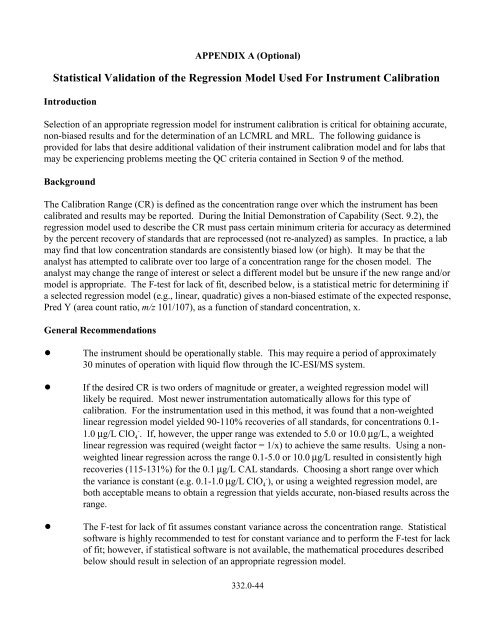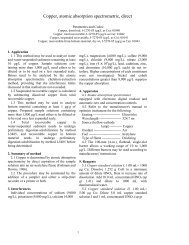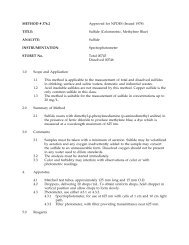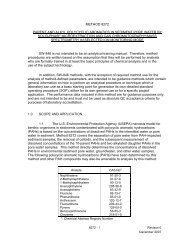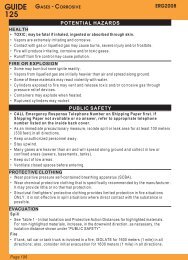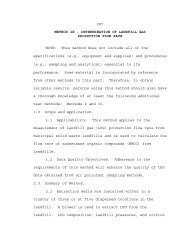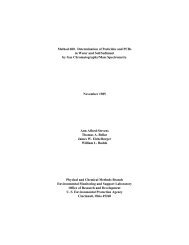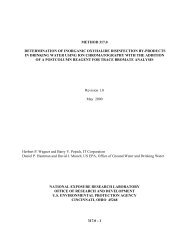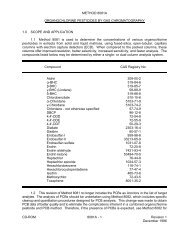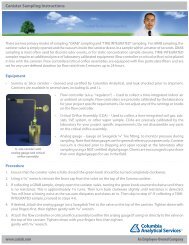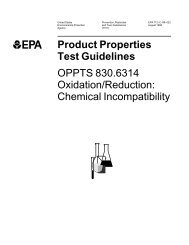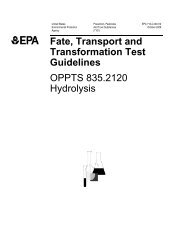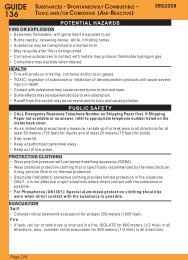View Actual EPA Method 332 (PDF File) - Columbia Analytical ...
View Actual EPA Method 332 (PDF File) - Columbia Analytical ...
View Actual EPA Method 332 (PDF File) - Columbia Analytical ...
You also want an ePaper? Increase the reach of your titles
YUMPU automatically turns print PDFs into web optimized ePapers that Google loves.
APPENDIX A (Optional)<br />
Statistical Validation of the Regression Model Used For Instrument Calibration<br />
Introduction<br />
Selection of an appropriate regression model for instrument calibration is critical for obtaining accurate,<br />
non-biased results and for the determination of an LCMRL and MRL. The following guidance is<br />
provided for labs that desire additional validation of their instrument calibration model and for labs that<br />
may be experiencing problems meeting the QC criteria contained in Section 9 of the method.<br />
Background<br />
The Calibration Range (CR) is defined as the concentration range over which the instrument has been<br />
calibrated and results may be reported. During the Initial Demonstration of Capability (Sect. 9.2), the<br />
regression model used to describe the CR must pass certain minimum criteria for accuracy as determined<br />
by the percent recovery of standards that are reprocessed (not re-analyzed) as samples. In practice, a lab<br />
may find that low concentration standards are consistently biased low (or high). It may be that the<br />
analyst has attempted to calibrate over too large of a concentration range for the chosen model. The<br />
analyst may change the range of interest or select a different model but be unsure if the new range and/or<br />
model is appropriate. The F-test for lack of fit, described below, is a statistical metric for determining if<br />
a selected regression model (e.g., linear, quadratic) gives a non-biased estimate of the expected response,<br />
Pred Y (area count ratio, m/z 101/107), as a function of standard concentration, x.<br />
General Recommendations<br />
! The instrument should be operationally stable. This may require a period of approximately<br />
30 minutes of operation with liquid flow through the IC-ESI/MS system.<br />
! If the desired CR is two orders of magnitude or greater, a weighted regression model will<br />
likely be required. Most newer instrumentation automatically allows for this type of<br />
calibration. For the instrumentation used in this method, it was found that a non-weighted<br />
linear regression model yielded 90-110% recoveries of all standards, for concentrations 0.1-<br />
1.0 µg/L ClO 4- . If, however, the upper range was extended to 5.0 or 10.0 µg/L, a weighted<br />
linear regression was required (weight factor = 1/x) to achieve the same results. Using a nonweighted<br />
linear regression across the range 0.1-5.0 or 10.0 µg/L resulted in consistently high<br />
recoveries (115-131%) for the 0.1 µg/L CAL standards. Choosing a short range over which<br />
the variance is constant (e.g. 0.1-1.0 µg/L ClO 4- ), or using a weighted regression model, are<br />
both acceptable means to obtain a regression that yields accurate, non-biased results across the<br />
range.<br />
! The F-test for lack of fit assumes constant variance across the concentration range. Statistical<br />
software is highly recommended to test for constant variance and to perform the F-test for lack<br />
of fit; however, if statistical software is not available, the mathematical procedures described<br />
below should result in selection of an appropriate regression model.<br />
<strong>332</strong>.0-44


